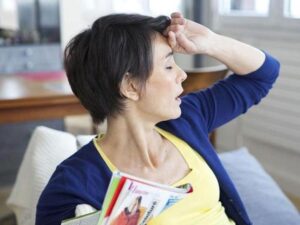Embarking on the journey of life, particularly for women, often involves navigating through various stages, each accompanied by its own set of challenges and triumphs. One such significant phase is menopause. This is a natural biological transition that marks the end of reproductive years. Amidst the multifaceted experiences that accompany this period, women commonly encounter vasomotor symptoms, which can have a profound impact on their daily lives. In this blog, we will explore the intricacies of vasomotor symptoms, shedding light on their nature, causes, and effective strategies for managing these waves of change.
Contents
What Is The Meaning Of Vasomotor?
 Vasomotor refers to the physiological regulation of blood vessel diameter and blood flow in response to various stimuli. The term is derived from the combination of two key components: “vaso,” relating to blood vessels, and “motor,” about movement or regulation. In the context of the body’s circulatory system, vasomotor activity involves the intricate coordination of smooth muscle cells that line blood vessels, influencing their constriction or dilation.
Vasomotor refers to the physiological regulation of blood vessel diameter and blood flow in response to various stimuli. The term is derived from the combination of two key components: “vaso,” relating to blood vessels, and “motor,” about movement or regulation. In the context of the body’s circulatory system, vasomotor activity involves the intricate coordination of smooth muscle cells that line blood vessels, influencing their constriction or dilation.
This dynamic process plays a crucial role in maintaining optimal blood pressure, distributing blood to different tissues as needed, and responding to changes in internal or external conditions. In a broader sense, the term “vasomotor” is often associated with the autonomic nervous system. This is particularly the sympathetic division, which governs involuntary bodily functions. Understanding vasomotor function is particularly relevant in the context of health.
What Are The Most Common Vasomotor Symptoms?
Vasomotor symptoms are often associated with changes in blood vessel activity and are commonly experienced during various life stages, particularly in women during menopause. The most prevalent vasomotor symptoms include:
Hot Flashes
Hot flashes are one of the hallmark vasomotor symptoms. These are characterized by sudden and intense waves of heat that spread across the upper body, often causing flushing of the face and neck. These episodes can be unpredictable and may be accompanied by sweating and an increased heart rate. The exact cause of hot flashes is not fully understood, but hormonal fluctuations, particularly the decline in estrogen levels during menopause, are believed to play a significant role.
Night Sweats
Night sweats are essentially hot flashes that occur during sleep. They involve episodes of profuse sweating that can drench sleepwear and bed sheets. The disruption of sleep due to night sweats can lead to fatigue, irritability, and difficulties concentrating during the day. Night sweats are a common vasomotor symptom during menopause and can contribute to sleep disturbances, which in turn may affect overall well-being.
Fluctuations in Body Temperature
Individuals experiencing vasomotor symptoms often report fluctuations in body temperature, feeling alternately too hot or too cold. These temperature fluctuations can occur spontaneously or in response to environmental conditions. The body’s struggle to regulate temperature contributes to the overall discomfort associated with vasomotor symptoms, creating a sense of internal imbalance.
Chills
Chills often follow a hot flash as the body attempts to cool down. This sudden cooling sensation can be accompanied by shivering and a feeling of coldness. The contrast between the heat of a hot flash and the subsequent chills adds to the physical and sensory challenges experienced by individuals going through vasomotor symptoms.
Skin Redness
Increased blood flow to the skin during hot flashes can lead to noticeable skin redness or blotchiness, especially on the face, neck, and upper chest. The visible signs of flushing can be distressing for some individuals, contributing to self-consciousness and impacting social interactions. Understanding and managing these physical manifestations is an essential aspect of coping with vasomotor symptoms.
Palpitations
 Palpitations, or the awareness of one’s heartbeat, can accompany vasomotor symptoms, adding a cardiovascular dimension to the overall experience. Individuals undergoing hot flashes or other vasomotor events may feel a rapid or irregular heartbeat, contributing to a sense of heightened physical awareness. While generally benign, palpitations can be disconcerting for some, and understanding their association with vasomotor symptoms is important for comprehensive symptom management.
Palpitations, or the awareness of one’s heartbeat, can accompany vasomotor symptoms, adding a cardiovascular dimension to the overall experience. Individuals undergoing hot flashes or other vasomotor events may feel a rapid or irregular heartbeat, contributing to a sense of heightened physical awareness. While generally benign, palpitations can be disconcerting for some, and understanding their association with vasomotor symptoms is important for comprehensive symptom management.
Headaches
Vasomotor symptoms, particularly the hormonal fluctuations associated with menopause, can contribute to the onset of headaches or migraines. Changes in blood flow and the dilation of blood vessels may play a role in triggering these headaches. The discomfort and intensity of headaches can vary, impacting daily activities and requiring specific approaches to manage both the underlying vasomotor symptoms and the associated head pain.
Dizziness
Fluctuations in blood pressure and circulation during vasomotor events can lead to feelings of lightheadedness or dizziness. This sensation is often more pronounced when transitioning from a sitting or lying down position to standing. Managing dizziness associated with vasomotor symptoms involves maintaining hydration, gradual movements, and in some cases, lifestyle adjustments to promote overall cardiovascular health.
Fatigue
The disruption of sleep due to night sweats or other vasomotor symptoms can contribute to increased fatigue. Persistent fatigue can have a cascading effect on overall well-being, influencing mood, cognitive function, and daily activities. Addressing fatigue involves not only managing the immediate symptoms but also implementing strategies to enhance sleep quality and overall energy levels.
Irritability and Mood Swings
Hormonal fluctuations associated with vasomotor symptoms, particularly the decline in estrogen, can impact mood regulation. Irritability and mood swings are common emotional responses, and individuals experiencing these symptoms may find themselves more sensitive to stressors. Recognizing the emotional component of vasomotor symptoms is crucial for holistic management, involving both physiological and psychological aspects of well-being.
These additional symptoms further underscore the multifaceted nature of vasomotor disturbances, impacting not only the physical well-being but also the emotional and psychological aspects of an individual’s health. While vasomotor symptoms are often temporary and part of natural life transitions like menopause, they can vary widely in severity and duration among different individuals.
How Can You Manage Vasomotor Symptoms?
 Managing vasomotor symptoms involves a combination of lifestyle changes, medical interventions, and supportive strategies tailored to individual needs. Here are several approaches that can help alleviate and cope with vasomotor symptoms:
Managing vasomotor symptoms involves a combination of lifestyle changes, medical interventions, and supportive strategies tailored to individual needs. Here are several approaches that can help alleviate and cope with vasomotor symptoms:
Hormone Therapy (HT)
For women experiencing severe vasomotor symptoms, hormone therapy may be considered. Estrogen, alone or in combination with progestin, can help regulate hormonal imbalances associated with menopause. However, the decision to pursue hormone therapy should be made in consultation with a healthcare provider, considering individual health risks and benefits.
Lifestyle Modifications
Adopting a healthy lifestyle can significantly impact the frequency and severity of vasomotor symptoms. This includes maintaining a balanced diet, staying hydrated, avoiding trigger foods (such as caffeine and spicy foods), and engaging in regular physical activity. These measures contribute to overall well-being and can help manage symptom intensity.
Cooling Techniques
Cooling strategies can provide relief during hot flashes. Dressing in layers allows for easy adjustment to changes in body temperature. Using fans, staying in well-ventilated spaces, and applying cool compresses can also help regulate body heat. Additionally, keeping a cold water bottle nearby can offer a quick way to cool down during a hot flash.
Stress Reduction
Stress is a known trigger for vasomotor symptoms. Practicing stress reduction techniques, such as deep breathing exercises, meditation, yoga, or mindfulness, can help mitigate the impact of stress on symptom occurrence. Engaging in activities that bring joy and relaxation can also contribute to overall emotional well-being.
Acupuncture and Alternative Therapies
Some individuals find relief from vasomotor symptoms through alternative therapies such as acupuncture. While scientific evidence varies, some studies suggest that acupuncture may help alleviate hot flashes. It’s important to discuss these options with a healthcare provider and ensure they complement an overall treatment plan.
Phytoestrogens and Herbal Supplements
Certain foods and supplements containing phytoestrogens, such as soy products and black cohosh, may offer relief for some individuals. However, their effectiveness can vary, and it’s crucial to consult with a healthcare provider before incorporating supplements into the routine, especially if there are pre-existing health conditions.
Consultation with Healthcare Providers
Regular communication with healthcare providers is crucial in managing vasomotor symptoms. They can provide guidance on the most suitable interventions, monitor overall health, and adjust treatment plans as needed. This collaborative approach ensures personalized care and maximizes the effectiveness of symptom management strategies.
Conclusion
In conclusion, understanding and managing vasomotor symptoms, particularly during life transitions like menopause, is a journey that involves a combination of lifestyle adjustments, medical guidance, and emotional support. From hot flashes to mood swings, these symptoms can vary widely, but there are practical strategies to navigate this phase with resilience. Lifestyle modifications, such as a healthy diet and regular exercise, play a crucial role, along with cooling techniques and stress reduction methods.
Consulting with healthcare providers for personalized advice, considering hormone therapy when appropriate, and building a supportive network can collectively empower individuals to embrace this natural stage of life with confidence and well-being. By taking a holistic approach and recognizing the uniqueness of each experience, one can sail through the waves of change, finding strength and comfort along the way.
If you are facing menopause related issues, menopause treatment at HerMantra can help. Book your free trial online menopause treatment session now.


